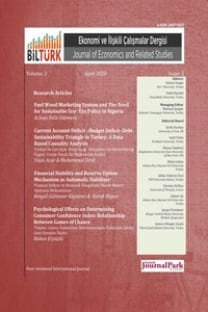Türkiye'de Suçun Sosyo-Ekonomik Belirleyicileri
Bu çalışma, suç ile sosyo- makro ekonomik değişkenler ve ayrıca siyasi şiddet arasındaki ilişkiyi araştırmaktadır. Bu ilişkiyi ortaya koyabilmek için vektör otoregresyon (VAR) modelinde, kişi başına GSYİH, enflasyon oranı, İşsiz sayısı, nüfus yoğunluğu, politik şiddet, eğitim seviyesi, gelir düzeyi ve polis sayısı bağımsız değişken olarak kullanılırken suç verileri bağımlı değişken olarak kullanılmıştır. Ayrıca, suç ve bağımsız değişkenler arasındaki nedensellik ilişkisinin ve hangi yönde olduğunu tespit etmek amacıyla Granger nedensellik analizi yapılmıştır. Elde edilen sonuçlara göre, suç ve sosyo-makro ekonomik değişkenler arasında ilişki tespit edilmiştir.
Anahtar Kelimeler:
Türkiye, Macroeconomics, Crime, VAR, Granger causality
Socio-Economic Determinants of Crime in Turkey
Abstract
This paper empirically assesses the relationship between crime and socio- macroeconomic variables, as well as political violence. In order to demonstrate this relationship, in the vector autoregression (VAR) model, GDP per capita, inflation rate, number of unemployed, population density, political violence, education level, income level and the number of police officers were used as independent variables, while crime data were used as dependent variables. In addition, Granger causality analysis was conducted to determine the causality relationship between crime and independent variables and in which direction. According to the results obtained, a relationship was determined between crime and socio-macro-economic variables.
___
- Adekoya, A.F. ve N.A.A. Razak (2016), “Inflation, Deterrence and Crime: Evidence from Nigeria using Bounds Test Approach “,Journal of Economics and Sustainable Development, 7(18), 23-32.
- Aksu, H. ve Akkuş, Y. (2010). Türkiye’de Mala Karşı Suçların Sosyoekonomik Belirleyicileri Üzerine Bir Deneme: Sınır Testi Yaklaşımı (1970- 2007). Sosyoekonomi: 1/ 100110, 191-214.
- Ata, Y. A. (2011). Ücretler, İşsizlik ve Suç Arasındaki İlişki: Yatay-Kesit Analizi. Çalışma ve Toplum: 4, 113-134.
- Baharom, A.H, M.S.Habibullah, Z.M.Noor (2013). “Crime and Its Socio-Macroeconomics Determinants: A Panel-Error-Correction Cointegration Analysis” Jurnal Ekonomi Malaysia 47(2), 13 - 24
- Becker, Gary S. (1968), “Crime and Punishment: An Economic Approach”, Journal of Political Economy, 76: 169-217.
- Buonanno, P. (2003), “The Socioeconomic Determinants of Crime. A Review of the Literature”, Unıversıty Of Mılan – Bıcocca, Department Of Economıcs Workıng Paper Serıes, 63.
- Buonanno P. ve D.Montolio (2008). “Identifying the socio-economic and demographic determinants of crime across Spanish provinces”, International Review of Law and Economics, 28, 89–97.
- Buonanno, P., F. Drago ve R. Galbiati (2014). “Response of Crime to Unemployment: An International Comparison” Journal of Contemporary Criminal Justice, 30(1), 29-40.
- Cantor, D. ve Land (1985), “Unemployment and Crime Rates In The Post-World War II United States: A Theoretıcal and Empırıcal Analysiıs”, American Sociological Review, 50 (3), 317-332
- Cömertler, C. ve M. Kar (2007). “Türkiye'de Suç Oranının Sosyo-Ekonomik Belirleyicileri: Yatay Kesıt Analız”, Ankara Üniversitesi SBF Dergisi, 62(2), 37-57.
- Ehrlich, I. (1973), “Participation in Illegitimate Activities: A Theoretical and Empirical Investigation”, Journal of Political Economy , 81 (3), 521-565.
- Gillani, S. Y. M., R. E. A Khan,. ve A. R Gill,. (2011). Unemployment and Property Crimes in Pakistan. Asian Economic and Financial Review, Vol.1 Iss.3, 125-135.
- Hamid, B.A., M.S.Habibullah ve Z.M.Noor, (2013). “Crime and Its Socio-Macroeconomics Determinants: A Panel-Error-Correction Cointegration Analysis”, Jurnal Ekonomi Malaysia 47(2), 13 – 24.
- Hazra, D. ve Zhen, C. (2018), “ Macroeconomic Determinants of Crime: Evidence from India”, J. Quant. Econ. , 16 (Suppl 1): 187–S198
- Johansen, S. (2002). A small sample correction for the test of cointegrating rank in the vector autoregressive model. Econometrica, 70(5), 1929-1961.
- Kizilgol, O. ve Selim S. (2017). “Socıo- Economıc And Demographıc Determınants Of Crıme By Panel Count Data Analysıs: The Case Of Eu 28 and Turkey”, Journal of Business, Economics and Finance, 4, 31-41.
- Lastauskas, P. ve E.Tatsi, (2013). Spatial Nexus in Crime and Unemployment in Times of Crisis: Evidence from Germany. University of Cambridge, Cambridge Working Papers in Economics, 1-50.
- Mulok, D., J. Lily, M. Kogid ve R. Asid (2016). “ The Relationship between Crime and Economic Growth in Malaysia: Re-Examine Using Bound Test Approach” Malaysian Journal of Business and Economics, 3(1), 15 – 26
- Pazarlıoğlu, M.V ve T.Turgutlu (2007). “Gelir, İşsizlik ve Suç: Türkiye Üzerine Bir İnceleme” Finans Politik & Ekonomik Yorumlar 513(44), 63-70.
- Roman, J. (2013). The puzzling relationship between crime and the economy. Download from http://www.citylab.com/work/2013/09/puzzling-relationship-between-crime-and-economy/ 6982/.
- Seals, A. ve J. Nunley (2007) The Effects of Inflatıon and Demographıc Change on Property Crıme: A Structural Tıme Serıes Approach, Department of Economics & Finance Working Paper Series
- Tang, C.F (2009), “The Linkages among Inflation, Unemployment and Crime Rates in Malaysia”, Int. Journal of Economics and Management 3(1), 50 – 61
- Tang, C. F., & Lean, H. H. (2007). Will inflation increase crime rate? New evidence from bounds and modified Wald tests. Global Crime, 8(4), 311-323.
- Tunca, H. (2019).Suçun Sosyo-ekonomik Belirleyicileri: Panel Veri Analizi. İnsan ve Toplum Bilimleri Araştırmaları Dergisi, 8(4), 2767-2784. www.itobiad.com/tr/issue/49747/602780
- Yılmaz, M. (2020). “Suç Ekonomisi ve İşsizlik üzerine bir Uygulama”, 19 Mayıs Sosyal Bilimler Dergisi, 1 (2), 103-124
- Yayın Aralığı: Yılda 4 Sayı
- Başlangıç: 2019
- Yayıncı: Fatih DEYNELİ
Sayıdaki Diğer Makaleler
Kamu Politikaları Doğrultusunda Devlete Olan Güvenin Yaşam Kalitesi Üzerindeki Etkisi
Yolsuzluk ve Kamu Kesimi Büyüklüğü: Panel Nedensellik Analizi ile Bir İnceleme
Türkiye’de Akıllı Şehir Uygulamasına Yerel Yönetimlerin Mali Görünümü Çerçevesinde Bir Bakış
Onur BALOĞLU, Pelin VAROL İYİDOĞAN
Melek BİNARBAŞI, Hakkı Hakan YILMAZ
